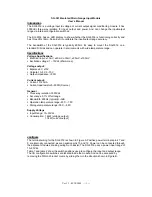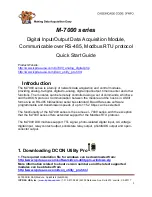
roughly constant above the torque peak. Consequently, the VE Table should be adjusted to reflect the fuel
requirements of an engine at all RPM’s (and volumetric efficiencies).
If you are not able to get an engine to idle with the VE Table settings, it may be time to use
TPS/MAP Blend. Blend is useful when the low-rpm pulsewidths are too high, and the VE Table
adjustments are at their maximum negative allowance.
B.6. Using TPS/MAP Blend
It is necessary to first read the theory of operation for TPS/MAP Blend in
Section D.4.e
of this
manual. The relevant terminology for the Blend function is defined in that section.
When an engine needs blend, it is usually best to enter the same Blend Percentage Values around
the idle RPM. That is, if an engine’s idle speed is 800rpm, set all Blend Percentages to the same value
from 1000rpm and below. This will keep the Blend routine from moving around with small idle RPM
changes.
As a starting point, set the Blend Percentage Value at 60% for all RPMs around and below the idle
speed. At around 200rpm above the idle speed, the Blend Percentage can be brought down smoothly to
zero at around 2000-5000rpm. The more radical the engine, the higher the RPM point for zero Blend
Percentage.
Optionally, the Blend Percentage can be set to a fixed level at all RPMs. This would effectively
make the system use the TPS reading as part of the load calculation
all the time
. Taking this to the
extreme, if the Blend Percentage was set to 100%, the load calculation would be
entirely TPS-based
. This
is generally not a good tuning method, since throttle position is not a very ideal load indicator.
The Blend function should be thought of as two things: a MAP sensor filter and a pulse width
modifier. When the MAP sensor reading is unsteady, but the engine is running at roughly the right pulse
width, the TPS/MAP Blend can be used to smooth out the MAP sensor reading, and therefore smooth out
the pulse width fluctuation. To accomplish this, enter a small amount of Blend Percentage (25-50%) near
the idle point. Raise the TPS Offset Voltage to increase the pulse width to the desired level. Lower the
TPS Offset Voltage if the engine is running too rich. The pulse width should stabilize once the proper
settings are established.
B.7. Tuning for Cold Engines and Cold Weather
When an engine is cold, or when the intake air is cold, it will require additional fuel. To add this
fuel, the
TECgt
uses coolant temperature enrichments that are activated as functions of cranking, normal
running, and accelerating. These enrichments are best tuned after an engine has been tuned when warm.
Tuning the cold enrichments before an engine has been tuned when warmed-up can be misleading.
To begin with, the most important coolant temperature (CLT)-based enrichment would be the
Warm-Up Enrichment. This enrichment adds a fixed percentage to the pulse width calculations as a
function of engine temperature. If an engine is tuned at 90C coolant temperature, the Warm-Up
Enrichment should be zeroed at 90C. At temperatures below 90C, the enrichment should ramp upward.
Starting a cold engine can also require an additional amount of fuel over and above that which is
necessary on a warm engine.
SE-0
and
ASE-0
from the Starting Enrichment section can be increased to
provide these enrichments as a function of engine temperature.
The Warm-Up Enrichment can be tuned by starting an engine when cold, and waiting for the 20
second enrichments to turn off (simply wait for 20 seconds after the engine has started). Add the required
Warm-Up Enrichment at the current coolant temperature to achieve a smooth idle. Smooth out the curve
from the current operating point to zero at 90C. For example, if the engine is at 30C and needs 40%
enrichment, ramp the enrichment from 40% at 30C to 0% at 90C. For temperatures below 30C, back-track
______________________________________________________________________________________
TECgt Manual Version 2.0
- Page 29 -
©2008 Electromotive, Inc.
















































